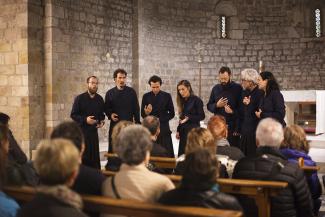
Being able to differentiate between "Brand" and "Projects" in the arts sectors allows us to effectively investigate the values that make them unique and, in this way, sustainable.
Brand and Projects are often confusedly related in cultural sectors. Although they are key elements for the success of the artistic works, it is convenient to clarify them and build specific narratives that define them.
Projects do not require a long life. They may be designed for a finite existence, at the end of which specific and, in most cases, quantifiable goals must have been achieved. The brands will be the umbrella of competencies that make the projects possible. A show, concert, workshop, etc. are projects created and produced by a company, artist, music band, artistic centre, etc., organizations that we can equate to a brand. Brands and projects in the arts are indivisible although they must be considered separately to carry out a career in the arts in a sustainable way.
In the example of the image that illustrates the article, the overtone singing choir "MuOM - Ecstatic Voices", their projects are the different kinds of concerts, recordings, audiovisuals, workshops, retreats, etc. a wide range of projects under the unique brand of "MuOM".
BRANDS AND PROJECTS FOR THE SUSTAINABLE DEVELOPMENT OF THE ARTS
As I defined in the article "4 Pillars of the Sustainable Development of the Arts", a key element designing artistic projects is the construction of unique and singular artistic narratives. Thus, each project, business model and the global brand have to define their own artistic narratives. Each entity or unit will articulate a different level of specificity, the most general being the one that refers to the global brand, and at the same time, where all the others are based. The global narrative shows the way, and dependent projects must show complete coherence with it.
The artistic narrative of a theatre company, music band or artistic centre must contain all the elements that define the ability to create and produce artists' projects. From a narrative constructed by answering the questions, what am I? what I do? how do i do it? what is my purpose? and why do I do it? an artist, group, organization or company communicates the essential and unique aspects that give credibility to their creative work.
The umbrella of the brand artistic narrative allows us to tackle a multi-offer project or multi-project with the assurance that all the projects generated respond to the same artistic and management criteria. Starting with the singular artistic language, the structure of the organization or the public or target clients to whom the works are aimed, the brand's narrative encompasses the set of characteristics for which each individual project is recognized as part of a whole.
If, for example, a theatre group clearly defines its unique artistic language, each show it produces is collectively recognizable and valued by the trajectory of the previous shows. But not only the shows, but also their education, audiovisual or research projects. The same thing happens with a writer, a visual artist, a concert hall or a school of artistic education. All of them, to the extent that their global narrative is complete and differentiated, will improve their chances for an efficient development of their multiple and diverse projects.
THE CROSSROADS OF DEFINING YOURSELF AS A BRAND OR AS A PROJECT
Sometimes leading artistic creation comes from one person, other times from broader groups of artists. All the work of creating a network of complicities and collaborations to carry out the projects falls on him, her or them. In these cases a crucial dilemma is the creation of the global brand. What can be more efficient for the development of the artistic career? define yourself as a personal brand? define yourself as a group? be defined by the projects? create an organizational structure, give it a name, and integrate more people? In general, all solutions are acceptable as long as the overall artistic narrative is appropriate and in tune with the chosen structure of the brand.
A personal brand will respond to the name of the artist and the narrative will be linked to talents, abilities and achievements. We know of countless artists in the visual arts, performing arts, music, and literature who are recognized by their personal brand name, and they sign and execute projects using this name. However, the artist may use the name of a group or company as a brand name and execute their projects by signing them with these brand names. Even more when it is a collective of artists. However, the effectiveness of each of the chosen options will lie in how their artistic narratives are defined.
DIAGNOSIS AS A TOOL FOR DEFINING BRANDS AND PROJECTS
Defining the personal brand or company brand takes time. It is a process of diagnosis, analysis and reflection. The strengths and weaknesses of each option have to be evaluated in depth, highlighting the advantages operating under the name of each of the selected brands. In addition, the description of the different creative capacities, and other capacities and resources involved in the design and implementation of the projects must also be taken into account. Thus, in order to make a decision of such strategic value regarding the sustainable development of organizations and their projects, a complete diagnosis is necessary. Having outside help to carry out this process allows obtaining substantial results in a shorter period of time.
